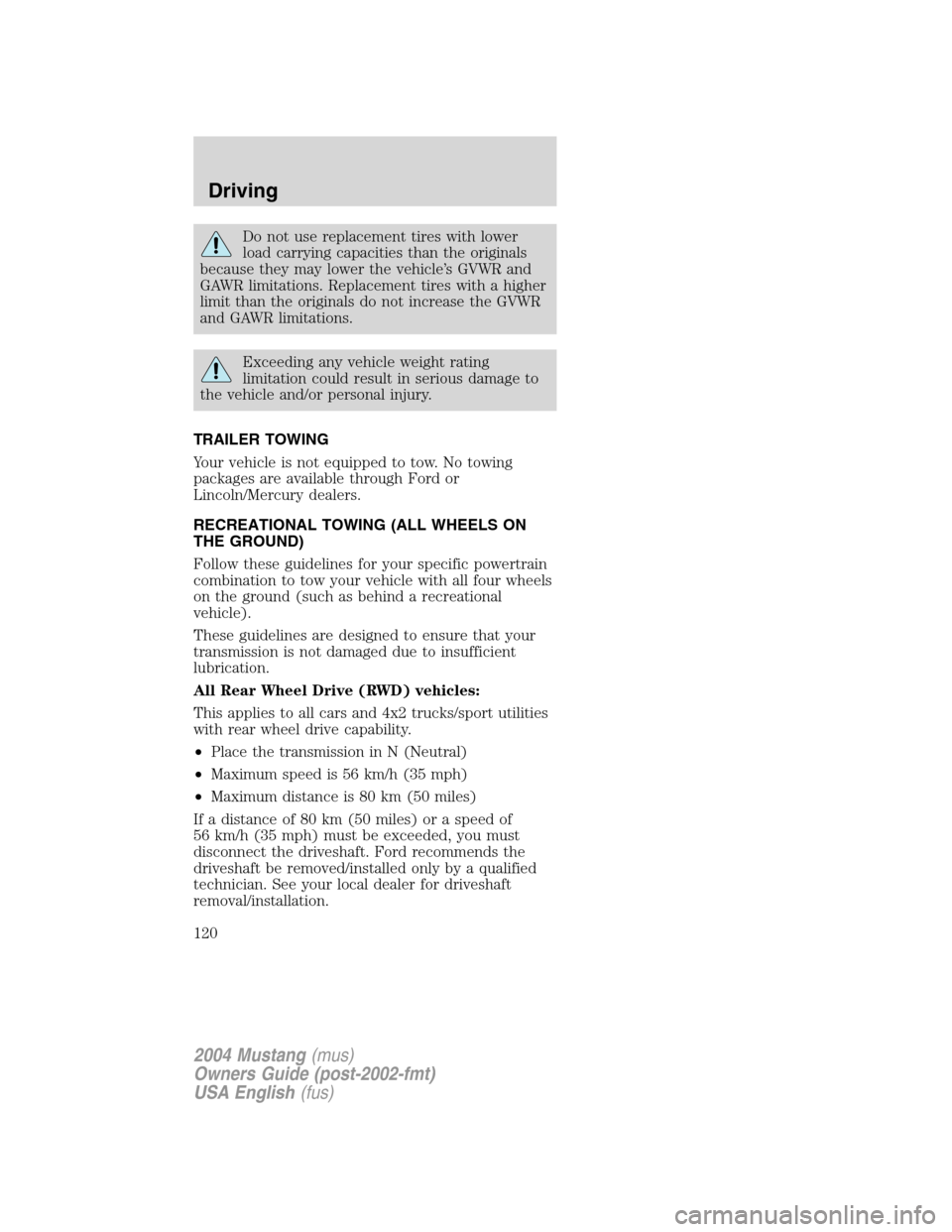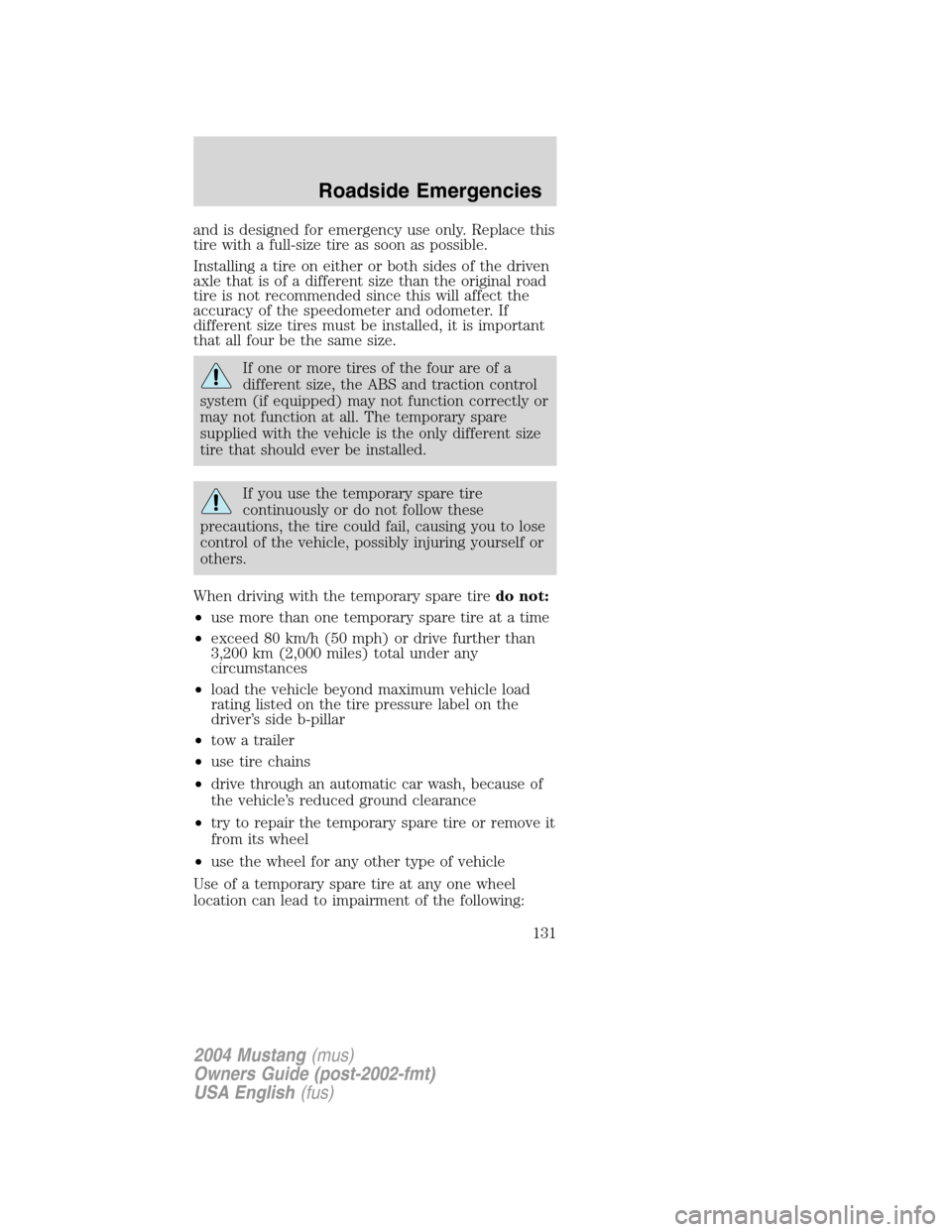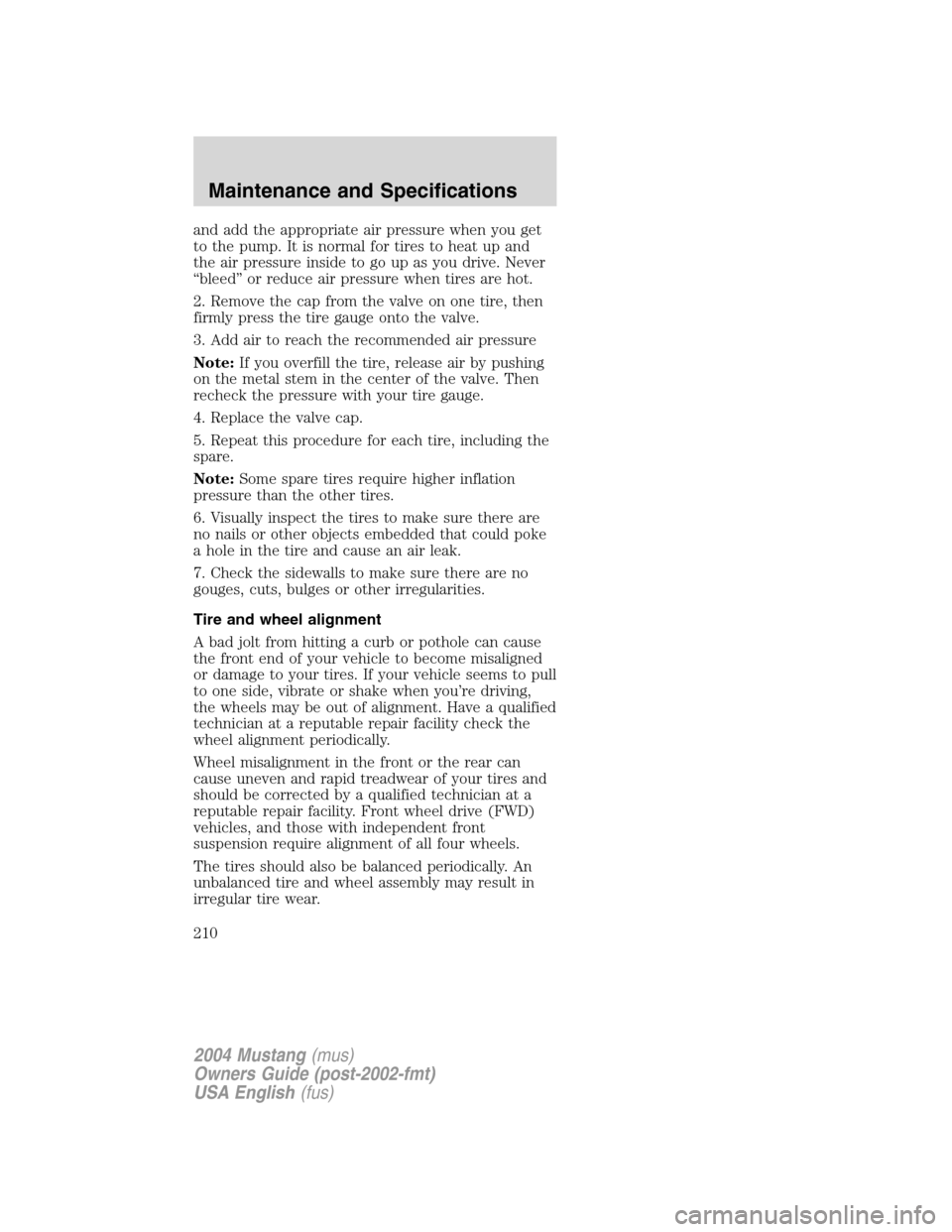Page 120 of 240

Do not use replacement tires with lower
load carrying capacities than the originals
because they may lower the vehicle’s GVWR and
GAWR limitations. Replacement tires with a higher
limit than the originals do not increase the GVWR
and GAWR limitations.
Exceeding any vehicle weight rating
limitation could result in serious damage to
the vehicle and/or personal injury.
TRAILER TOWING
Your vehicle is not equipped to tow. No towing
packages are available through Ford or
Lincoln/Mercury dealers.
RECREATIONAL TOWING (ALL WHEELS ON
THE GROUND)
Follow these guidelines for your specific powertrain
combination to tow your vehicle with all four wheels
on the ground (such as behind a recreational
vehicle).
These guidelines are designed to ensure that your
transmission is not damaged due to insufficient
lubrication.
All Rear Wheel Drive (RWD) vehicles:
This applies to all cars and 4x2 trucks/sport utilities
with rear wheel drive capability.
•Place the transmission in N (Neutral)
•Maximum speed is 56 km/h (35 mph)
•Maximum distance is 80 km (50 miles)
If a distance of 80 km (50 miles) or a speed of
56 km/h (35 mph) must be exceeded, you must
disconnect the driveshaft. Ford recommends the
driveshaft be removed/installed only by a qualified
technician. See your local dealer for driveshaft
removal/installation.
2004 Mustang(mus)
Owners Guide (post-2002-fmt)
USA English(fus)
Driving
120
Page 131 of 240

and is designed for emergency use only. Replace this
tire with a full-size tire as soon as possible.
Installing a tire on either or both sides of the driven
axle that is of a different size than the original road
tire is not recommended since this will affect the
accuracy of the speedometer and odometer. If
different size tires must be installed, it is important
that all four be the same size.
If one or more tires of the four are of a
different size, the ABS and traction control
system (if equipped) may not function correctly or
may not function at all. The temporary spare
supplied with the vehicle is the only different size
tire that should ever be installed.
If you use the temporary spare tire
continuously or do not follow these
precautions, the tire could fail, causing you to lose
control of the vehicle, possibly injuring yourself or
others.
When driving with the temporary spare tire do not:
• use more than one temporary spare tire at a time
• exceed 80 km/h (50 mph) or drive further than
3,200 km (2,000 miles) total under any
circumstances
• load the vehicle beyond maximum vehicle load
rating listed on the tire pressure label on the
driver’s side b-pillar
• tow a trailer
• use tire chains
• drive through an automatic car wash, because of
the vehicle’s reduced ground clearance
• try to repair the temporary spare tire or remove it
from its wheel
• use the wheel for any other type of vehicle
Use of a temporary spare tire at any one wheel
location can lead to impairment of the following:
2004 Mustang (mus)
Owners Guide (post-2002-fmt)
USA English (fus)
Roadside Emergencies
131
Page 210 of 240

and add the appropriate air pressure when you get
to the pump. It is normal for tires to heat up and
the air pressure inside to go up as you drive. Never
“bleed”or reduce air pressure when tires are hot.
2. Remove the cap from the valve on one tire, then
firmly press the tire gauge onto the valve.
3. Add air to reach the recommended air pressure
Note:If you overfill the tire, release air by pushing
on the metal stem in the center of the valve. Then
recheck the pressure with your tire gauge.
4. Replace the valve cap.
5. Repeat this procedure for each tire, including the
spare.
Note:Some spare tires require higher inflation
pressure than the other tires.
6. Visually inspect the tires to make sure there are
no nails or other objects embedded that could poke
a hole in the tire and cause an air leak.
7. Check the sidewalls to make sure there are no
gouges, cuts, bulges or other irregularities.
Tire and wheel alignment
A bad jolt from hitting a curb or pothole can cause
the front end of your vehicle to become misaligned
or damage to your tires. If your vehicle seems to pull
to one side, vibrate or shake when you’re driving,
the wheels may be out of alignment. Have a qualified
technician at a reputable repair facility check the
wheel alignment periodically.
Wheel misalignment in the front or the rear can
cause uneven and rapid treadwear of your tires and
should be corrected by a qualified technician at a
reputable repair facility. Front wheel drive (FWD)
vehicles, and those with independent front
suspension require alignment of all four wheels.
The tires should also be balanced periodically. An
unbalanced tire and wheel assembly may result in
irregular tire wear.
2004 Mustang(mus)
Owners Guide (post-2002-fmt)
USA English(fus)
Maintenance and Specifications
210
Page 211 of 240
Tire rotation
Rotating your tires at the recommended interval (as
indicated in the Service Maintenance Guide that
comes with your vehicle) will help your tires wear
more evenly providing better tire performance and
longer tire life. Unless otherwise specified, rotate the
tires approximately every 8,000 km (5,000 miles).
•Front Wheel Drive
(FWD) vehicles
(front tires at top of
diagram)
•Rear Wheel Drive
(RWD) vehicles/Four
Wheel Drive (4WD)
vehicles (front tires
at top of diagram)
Sometimes irregular tire wear can be corrected by
rotating the tires.
2004 Mustang(mus)
Owners Guide (post-2002-fmt)
USA English(fus)
Maintenance and Specifications
211